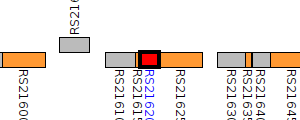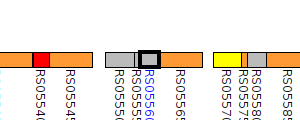In order to generate a more inclusive dataset of Pseudomonas genes mapped to putative in-paralogs and putative orthologs in other Pseudomonas species/strains, we developed a Pseudomonas Orthologous Groups classification system.
To generate ortholog groups, pair-wise DIAMOND searches were run on all genomes in the database to find reciprocal best hits (RBHs) for each gene. These analyses often resulted in multiple candidate genes for RBH status, which were narrowed down by examining the similarity between the query's flanking genes and the hit's flanking genes. If two candidate genes were directly adjacent, they where both accepted as RBHs that involve putative in-parology.
Pairwise intra-genome DIAMOND searches were also performed to acquire in-paralog information (i.e. gene duplications occurring after species divergence). If two genes in one genome were reciprocally more similar to each other than to any gene in the other genomes, the two genes were designated putative in-paralogs. Ortholog groups are built by starting with a seed gene and then adding all genes to which there is a RBH or in-paralog relationship.
Every new gene added to an ortholog group was then treated as a seed gene and the addition process was repeated until all qualifying genes had been added. The result was the development of orthologous groups, specifically generated for Pseudomonas species genomes, which can be used to sort search results.
Pseudomonas Ortholog Group POG003806
| Strain | Locus Tag | Description | Same-Strain Members | Fragment ? | |
|---|---|---|---|---|---|
| Pseudomonas fluorescens Pf0-1 | Pfl01_1822 |
cbb3-type cytochrome c oxidase subunit II
|
1 member |

|
|
| Pseudomonas fluorescens PICF7 | PFLUOLIPICF7_RS15730 |
peptidase S41
|
1 member |

|
|
| Pseudomonas fluorescens Q2-87 | PflQ2_3650 |
peptidase S41
ccoO |
1 member |

|
|
| Pseudomonas fluorescens R124 | I1A_001789 |
peptidase S41
|
2 same-strain members: I1A_001789 I1A_001793 |

|
|
| Pseudomonas fluorescens R124 | I1A_001793 |
peptidase S41
|
2 same-strain members: I1A_001789 I1A_001793 |

|
|
| Pseudomonas fluorescens SF39a | NX10_RS21620 |
peptidase S41
|
2 same-strain members: NX10_RS21620 NX10_RS21640 |

|
|
| Pseudomonas fluorescens SF39a | NX10_RS21640 |
peptidase S41
|
2 same-strain members: NX10_RS21620 NX10_RS21640 |

|
|
| Pseudomonas fluorescens SF4c | QS95_RS18125 |
peptidase S41
|
1 member |

|
|
| Pseudomonas fluorescens SS101 | PflSS101_3883 |
peptidase S41
ccoO_1 |
2 same-strain members: PflSS101_3883 PflSS101_3887 |

|
|
| Pseudomonas fluorescens SS101 | PflSS101_3887 |
peptidase S41
ccoO_2 |
2 same-strain members: PflSS101_3883 PflSS101_3887 |

|
|
| Pseudomonas fluorescens UK4 | HZ99_RS08075 |
cbb3-type cytochrome c oxidase subunit II
|
1 member |

|
|
| Pseudomonas frederiksbergensis SI8 - Assembly GCF_000802155.2 | JZ00_RS09990 |
cbb3-type cytochrome c oxidase subunit II
|
1 member |

|
|
| Pseudomonas fulva 12-X | Psefu_2863 |
cytochrome c oxidase, cbb3-type subunit II
|
1 member |

|
|
| Pseudomonas fulva NBRC 16636 = DSM 17004 - Assembly GCF_000621265.1 | Q382_RS0118675 |
cytochrome c oxidase, cbb3-type, subunit II
|
1 member |

|
|
| Pseudomonas fulva NBRC 16636 = DSM 17004 - Assembly GCF_000730565.1 | PFU01S_RS05560 |
cytochrome c oxidase cbb3-type subunit II
|
1 member |

|
|
| Pseudomonas helleri DSM 29165 | TU84_RS09595 |
cbb3-type cytochrome c oxidase subunit II
|
2 same-strain members: TU84_RS09595 TU84_RS09615 |

|
|
| Pseudomonas helleri DSM 29165 | TU84_RS09615 |
cbb3-type cytochrome c oxidase subunit II
|
2 same-strain members: TU84_RS09595 TU84_RS09615 |

|
|
| Pseudomonas kilonensis 1855-344 | VP02_RS25500 |
peptidase S41
|
1 member |

|
|
| Pseudomonas knackmussii B13 | PKB_RS10585 |
cbb3-type cytochrome c oxidase subunit II
|
2 same-strain members: PKB_RS10585 PKB_RS10605 |

|
|
| Pseudomonas knackmussii B13 | PKB_RS10605 |
cbb3-type cytochrome c oxidase subunit II
|
2 same-strain members: PKB_RS10585 PKB_RS10605 |

|